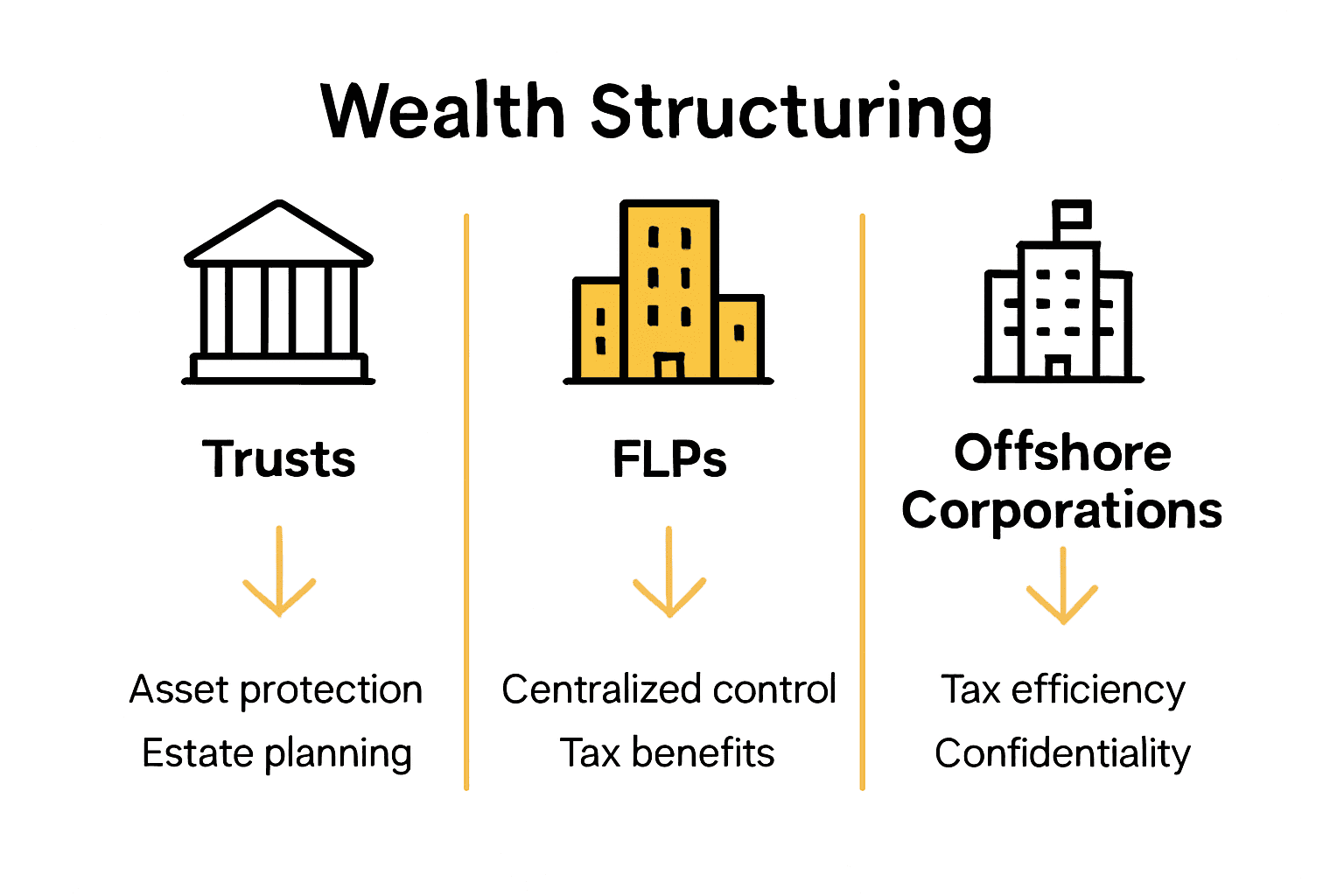More than 80 percent of ultra-wealthy families face significant risks when structuring their assets for growth and protection. The way wealth is organized shapes not only individual prosperity but also long-term family stability and legacy. With financial laws and global markets evolving rapidly, understanding core principles of wealth structuring gives you the power to maximize opportunities, minimize risks, and build a resilient financial future that stands the test of time.
Table of Contents
- Defining Wealth Structuring And Core Principles
- Major Wealth Structuring Vehicles And Tools
- Wealth Structuring Strategies For UHNW Families
- Legal Frameworks And Regulatory Considerations
- Risks, Costs, And Common Pitfalls To Avoid
Key Takeaways
| Point | Details |
|---|---|
| Holistic Wealth Structuring | Effective wealth structuring integrates financial, legal, and strategic considerations to achieve personal and familial financial goals. |
| Importance of Continuous Assessment | Wealth structuring is an ongoing process that requires regular evaluation to adapt to market changes and personal circumstances. |
| Diverse Wealth Structuring Vehicles | Various tools, such as trusts and family limited partnerships, offer unique advantages in asset management and tax efficiency. |
| Awareness of Risks and Compliance | Understanding potential risks, legal frameworks, and compliance is essential to avoid pitfalls in wealth structuring efforts. |
Defining Wealth Structuring and Core Principles
Wealth structuring represents a strategic approach to organizing, protecting, and optimizing financial assets across multiple dimensions. At its core, wealth structuring is not merely about accumulation but about creating a comprehensive framework that balances individual financial goals with broader economic considerations.
According to research from Cambridge Core, wealth is a nuanced combination of private and public resources, emphasizing that effective wealth structuring extends beyond personal financial management. This perspective highlights several critical principles:
- Holistic Asset Management: Integrating financial, legal, and strategic considerations
- Risk Mitigation: Designing structures that protect assets from potential vulnerabilities
- Tax Optimization: Strategically positioning assets to minimize tax liabilities
- Generational Wealth Transfer: Creating mechanisms for sustainable wealth preservation
The structural complexity of wealth ownership requires a dynamic approach that adapts to changing economic landscapes. As explored in Cambridge Core’s economic analysis, financial structures significantly impact wealth distribution and economic stability. Successful wealth structuring demands continuous assessment, strategic planning, and a forward-looking perspective that anticipates potential market shifts and personal financial evolution.
Key strategic considerations include understanding legal frameworks, leveraging appropriate financial instruments, and maintaining flexibility to adjust strategies as personal and economic circumstances change. Wealth structuring is not a one-time event but an ongoing process of aligning financial resources with long-term personal and familial objectives.
Major Wealth Structuring Vehicles and Tools
Wealth structuring vehicles represent sophisticated financial mechanisms designed to optimize asset management, protection, and transfer. These tools enable ultra-high-net-worth individuals and family offices to strategically navigate complex financial landscapes while maintaining maximum control and efficiency.
According to research from the International Monetary Fund, wealth taxation approaches play a critical role in understanding how different structuring vehicles can be strategically employed. The primary wealth structuring vehicles include:
Here’s a comparison of major wealth structuring vehicles and their primary advantages:
| Vehicle | Key Advantages | Typical Use Case |
|---|---|---|
| Trusts | Asset protection Tax efficiency Inheritance control |
Family wealth transfer |
| Family Limited Partnerships | Asset consolidation Centralized management Estate planning |
Multi-generation ownership |
| Offshore Corporations | Global diversification Asset shielding Tax optimization |
International asset protection |
| Private Investment Companies | Flexible investments Risk isolation Operational control |
Sophisticated asset management |
| Foundations | Philanthropy Legacy building Tax benefits |
Charitable giving & preservation |
- Trusts: Legal arrangements allowing controlled asset management and inheritance
- Family Limited Partnerships (FLPs): Vehicles for consolidating family assets with strategic ownership
- Offshore Corporations: International structures for global asset protection
- Private Investment Companies: Flexible entities for sophisticated investment management
- Foundations: Philanthropic and wealth preservation instruments
Additional insights from the OECD’s financial wealth analysis underscore the importance of understanding how different wealth vehicles interact with broader financial ecosystems. Each structuring tool offers unique advantages in tax efficiency, legal protection, and generational wealth transfer.

Successful implementation requires comprehensive understanding of each vehicle’s legal nuances, potential tax implications, and alignment with specific financial objectives.
 Professionals must carefully evaluate individual circumstances, risk tolerance, and long-term strategic goals when selecting and designing appropriate wealth structuring solutions. For those seeking deeper insights into personalized wealth transfer strategies, our guide on wealth transfer planning provides comprehensive professional perspectives.
Professionals must carefully evaluate individual circumstances, risk tolerance, and long-term strategic goals when selecting and designing appropriate wealth structuring solutions. For those seeking deeper insights into personalized wealth transfer strategies, our guide on wealth transfer planning provides comprehensive professional perspectives.
Wealth Structuring Strategies for UHNW Families
Ultra-high-net-worth (UHNW) families require sophisticated, multifaceted wealth structuring strategies that go beyond traditional financial planning. These strategies demand a holistic approach that integrates complex financial management, legal protection, and intergenerational wealth preservation.
According to research from IESE Business School, strategic wealth creation hinges on seven critical principles that UHNW families must carefully consider:
- Core Competency Development: Identifying and leveraging unique family strengths
- Dynamic Risk Management: Proactively mitigating potential financial vulnerabilities
- Strategic Diversification: Spreading investments across multiple asset classes and geographies
- Efficient Capital Execution: Optimizing resource allocation and investment strategies
- Long-Term Vision: Creating sustainable wealth frameworks beyond immediate financial gains
- Comprehensive Governance: Establishing clear decision-making protocols
- Continuous Learning: Adapting strategies to evolving economic landscapes
Research from Cambridge University emphasizes the broader responsibility of wealth creation, highlighting that successful strategies must balance private wealth accumulation with broader societal considerations. This approach requires UHNW families to think beyond mere financial returns and consider their broader economic and social impact.
For families seeking to refine their wealth structuring approach, understanding nuanced tax planning becomes crucial.
Our comprehensive guide on tax planning for family offices provides detailed insights into navigating complex financial landscapes while maintaining strategic flexibility and compliance.
Legal Frameworks and Regulatory Considerations
Legal frameworks represent the intricate backbone of sophisticated wealth structuring, providing essential guardrails that define the boundaries of financial strategy and asset protection. These complex systems determine how individuals and families can legally optimize, preserve, and transfer their wealth across jurisdictions and generations.
Research from Cambridge University highlights the critical intersection between legal registration, taxation policies, and wealth management. Key regulatory considerations for wealth structuring include:
- Jurisdictional Compliance: Understanding multiple legal systems
- Tax Optimization: Navigating complex international tax regulations
- Asset Protection: Implementing legal shields against potential liabilities
- Transparency Requirements: Meeting global reporting and disclosure standards
- Inheritance Regulations: Structuring intergenerational wealth transfer
Additional insights from the National Bureau of Economic Research emphasize a sociological perspective on wealth inequality, suggesting that legal frameworks are not merely technical constructs but reflection of broader social and economic dynamics. Successful wealth structuring requires a nuanced understanding of these interconnected legal and regulatory landscapes.
Professionals must stay ahead of evolving regulatory environments, anticipating potential changes and maintaining flexible structures. Our comprehensive guide on private wealth structuring steps offers in-depth strategies for navigating these complex legal considerations while maintaining optimal asset protection and strategic flexibility.
Risks, Costs, and Common Pitfalls to Avoid
Wealth structuring involves navigating a complex landscape of potential risks and financial challenges that can significantly impact long-term financial strategies. Understanding these potential pitfalls is crucial for ultra-high-net-worth families seeking to preserve and grow their wealth effectively.
According to research from the International Monetary Fund, wealth taxation presents numerous challenges that can create substantial economic distortions. The most critical risks and pitfalls include:
- Regulatory Compliance Failures: Unexpected legal complications
- Tax Optimization Mistakes: Unintended tax liabilities
- Inadequate Risk Management: Exposure to market volatility
- Insufficient Diversification: Concentration of assets in limited sectors
- Poor Governance Structures: Lack of clear decision-making protocols
- Ineffective Succession Planning: Potential family wealth disintegration
- Overlooking Global Economic Shifts: Failure to adapt to changing markets
Research from IESE Business School emphasizes the critical importance of strategic risk management. Successful wealth preservation requires a proactive approach that anticipates potential challenges and develops robust mitigation strategies.
Professionals must remain vigilant and continuously reassess their wealth structuring strategies. Our comprehensive guide on private wealth structuring steps provides detailed insights into navigating these complex challenges while maintaining optimal asset protection and strategic flexibility.
Master Your Wealth Structuring Challenges with Expert Support
The path to effective wealth structuring is filled with complex strategies, legal hurdles, and the risk of costly missteps. Whether you are looking to optimize tax efficiency, protect assets through trusts or offshore entities, or design lasting generational wealth transfer plans, these challenges can feel overwhelming. This article highlighted key pain points such as navigating regulatory compliance, avoiding succession planning pitfalls, and balancing risk management with long-term vision. If you want clarity and confidence amid these complexities, you are not alone.

Take control of your wealth’s future today by connecting with a trusted community of family offices, wealth advisors, and service providers. Visit Future Family Office to explore expert resources tailored to UHNW families seeking tailored wealth structuring solutions. Discover insights, find specialized professionals, and stay ahead of tax and legal changes by joining a platform that makes private wealth management accessible and transparent. Your next strategic move toward lasting wealth preservation begins at Future Family Office. Start now and secure a smarter wealth structure for generations to come.
Frequently Asked Questions
What is wealth structuring?
Wealth structuring is a strategic approach to organizing, protecting, and optimizing financial assets, balancing personal financial goals with broader economic considerations.
What are some common tools used in wealth structuring?
Common wealth structuring vehicles include trusts, family limited partnerships, offshore corporations, private investment companies, and foundations, each offering unique advantages in asset management and protection.
How can ultra-high-net-worth families effectively manage their wealth?
UHNW families can effectively manage their wealth by implementing multifaceted strategies that include risk management, strategic diversification, governance, and a long-term vision for wealth preservation and generation.
What are the main risks to consider when structuring wealth?
Key risks in wealth structuring include regulatory compliance failures, tax optimization mistakes, inadequate risk management, insufficient diversification, and poor governance structures, all of which can impact long-term financial strategies.




